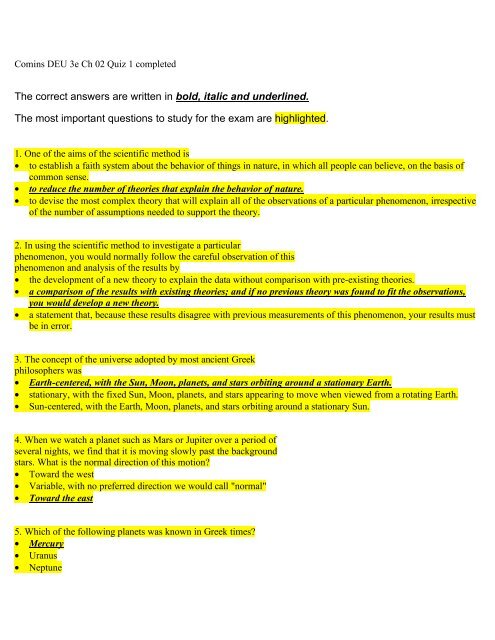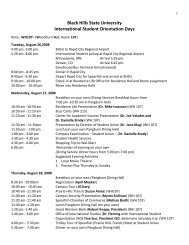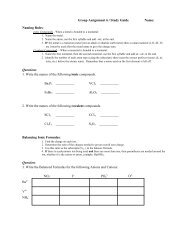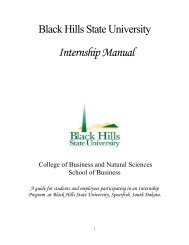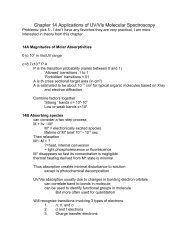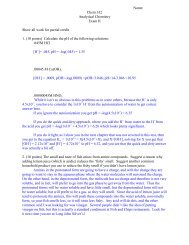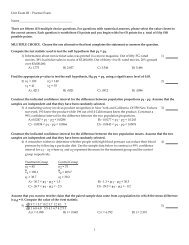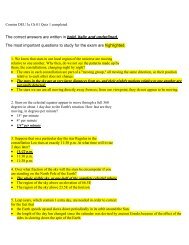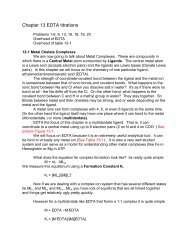The correct answers are written in bold, italic and underlined. The ...
The correct answers are written in bold, italic and underlined. The ...
The correct answers are written in bold, italic and underlined. The ...
You also want an ePaper? Increase the reach of your titles
YUMPU automatically turns print PDFs into web optimized ePapers that Google loves.
Com<strong>in</strong>s DEU 3e Ch 02 Quiz 1 completed<strong>The</strong> <strong>correct</strong> <strong>answers</strong> <strong>are</strong> <strong>written</strong> <strong>in</strong> <strong>bold</strong>, <strong>italic</strong> <strong>and</strong> underl<strong>in</strong>ed.<strong>The</strong> most important questions to study for the exam <strong>are</strong> highlighted.1. One of the aims of the scientific method is• to establish a faith system about the behavior of th<strong>in</strong>gs <strong>in</strong> nature, <strong>in</strong> which all people can believe, on the basis ofcommon sense.• to reduce the number of theories that expla<strong>in</strong> the behavior of nature.• to devise the most complex theory that will expla<strong>in</strong> all of the observations of a particular phenomenon, irrespectiveof the number of assumptions needed to support the theory.2. In us<strong>in</strong>g the scientific method to <strong>in</strong>vestigate a particularphenomenon, you would normally follow the c<strong>are</strong>ful observation of thisphenomenon <strong>and</strong> analysis of the results by• the development of a new theory to expla<strong>in</strong> the data without comparison with pre-exist<strong>in</strong>g theories.• a comparison of the results with exist<strong>in</strong>g theories; <strong>and</strong> if no previous theory was found to fit the observations,you would develop a new theory.• a statement that, because these results disagree with previous measurements of this phenomenon, your results mustbe <strong>in</strong> error.3. <strong>The</strong> concept of the universe adopted by most ancient Greekphilosophers was• Earth-centered, with the Sun, Moon, planets, <strong>and</strong> stars orbit<strong>in</strong>g around a stationary Earth.• stationary, with the fixed Sun, Moon, planets, <strong>and</strong> stars appear<strong>in</strong>g to move when viewed from a rotat<strong>in</strong>g Earth.• Sun-centered, with the Earth, Moon, planets, <strong>and</strong> stars orbit<strong>in</strong>g around a stationary Sun.4. When we watch a planet such as Mars or Jupiter over a period ofseveral nights, we f<strong>in</strong>d that it is mov<strong>in</strong>g slowly past the backgroundstars. What is the normal direction of this motion?• Toward the west• Variable, with no preferred direction we would call "normal"• Toward the east5. Which of the follow<strong>in</strong>g planets was known <strong>in</strong> Greek times?• Mercury• Uranus• Neptune
• Midnight• Noon13. <strong>The</strong> true orbital period of a planet around the Sun, comp<strong>are</strong>d to thebackground stars, is called its• synodic period.• sidereal period.• rotation period.14. A friend from New York City tells you that she saw Venus high <strong>in</strong> thesky at midnight on Christmas Day <strong>in</strong> 2004. Why do you know that she iswrong?• Venus is always too fa<strong>in</strong>t to be seen <strong>in</strong> the w<strong>in</strong>ter from the northern hemisphere.• <strong>The</strong> orbit of Venus is close to the ecliptic, <strong>and</strong> therefore it cannot be seen from the latitude of New York City.• Venus is an <strong>in</strong>ferior planet <strong>and</strong> always sets before midnight because it rema<strong>in</strong>s close to the Sun <strong>in</strong> our sky.15. Suppose that on some particular day the straight l<strong>in</strong>e from the Sunto the Earth cont<strong>in</strong>ues on to pass through Mars <strong>and</strong> ultimately throughsome particular star <strong>in</strong> the sky. (Draw<strong>in</strong>g a diagram might be helpful.)One synodic period later, Mars will aga<strong>in</strong> be l<strong>in</strong>ed up• with the star <strong>and</strong> the Sun, but not with the Earth.• with the Earth <strong>and</strong> the star, but not with the Sun.• with the Earth <strong>and</strong> the Sun, but not with the star.16. <strong>The</strong> synodic period for a planet is different from its siderealperiod because• the Earth (<strong>and</strong> hence the observer) moves.• the planet's speed varies as it moves around the Sun <strong>in</strong> its orbit.• the planet's orbital distance from the Sun is different from that of the Earth from the Sun.17. Tycho Brahe's major contribution to the development of modernastronomy was• the detailed <strong>and</strong> precise measurement of the positions of stars <strong>and</strong> planets <strong>in</strong> our sky.• a detailed <strong>and</strong> successful description of how a star can explode.• the first telescope observations of the variation of app<strong>are</strong>nt shapes <strong>and</strong> sizes of planets, particularly Venus <strong>and</strong>Mercury.18. <strong>The</strong> shape of the Earth's orbit around the Sun is• elliptical, with the Sun at the center of the ellipse.
• circular, s<strong>in</strong>ce all orbits of planets have to be circular <strong>in</strong> order to ma<strong>in</strong>ta<strong>in</strong> a constant distance from the Sun.• elliptical, with the Sun at a po<strong>in</strong>t known as a focus of the ellipse.19. Which of the follow<strong>in</strong>g methods could one use to demonstrate that theEarth's distance from the Sun varies as a consequence of its ellipticalorbit?• Measure the variation <strong>in</strong> the length of the shadow of a vertical pole produced by the Sun at midday throughout theyear• Measure the time between successive passages of a given star through your zenith• Measure the angular size of the Sun dur<strong>in</strong>g the year20. An object orbit<strong>in</strong>g the Sun with an orbital eccentricity of 0.1 hasan orbit whose shape is• circular, but with the Sun off-center <strong>in</strong> the circle.• a long, narrow ellipse.• slightly elliptical, but almost circular.


